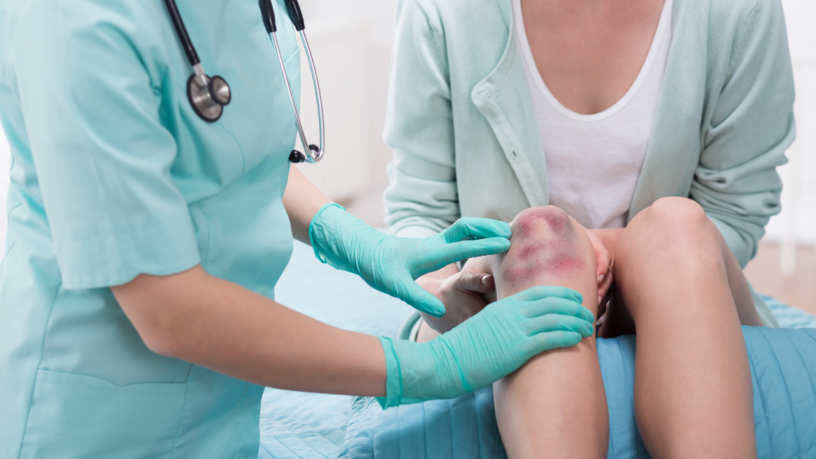Bruises can result from surgical procedures and accidental injuries—slips on icy walks, car crashes, and so forth. No matter how you sustain one, a bruise (also called a contusion) represents soft tissue trauma. The skin turns plum-colored because burst blood vessels have spilled red blood cells into the surrounding tissue. Later, breakdown products from those cells create green and yellow hues. Extra fluid in the tissues causes swelling. And, unfortunately, there’s some degree of tenderness. Deeper bruising of muscle and the lining of bones may be particularly painful.


1. Cold Pack
How it works: Immediate application of an ice pack can help slow, or even prevent, swelling from a bruise.
- PREPARATION: 6 ice cubes, crushed
- DIRECTIONS: Place the ice in a resealable plastic bag. Wrap in a clean cloth. Apply to the bruised area for 15 to 20 minutes. Repeat at least three times a day.
- YIELD: 01 APPLICATION
2. Elevation Salvation
How it works: Keeping the bruised area above your heart level and applying ice will help minimize swelling.
- PREPARATION:
- 3 pillows
- Your bruised area
- An ice pack (see Cold Pack, at left)
- DIRECTIONS: Sit or lie in a comfortable position. Pile up the pillows in a strategic place. Rest the bruised arm, leg, foot, or head against the pillows so that the area is above heart level. Apply the ice pack. Practice this as often as possible when the injury first occurs.
- YIELD: 01 APPLICATION
3. Aloe Vera Gel
How it works: Turmeric and ginger are both anti-inflammatory and analgesic. Peppermint reduces pain. Aloe vera is anti-inflammatory and speeds wound healing. Because aloe is readily absorbed into the skin, it may help drag other chemical ingredients along with it.
- PREPARATION:
- 2 tablespoons (28 g) Aloe vera gel
- 1 tablespoon (6.8) ground turmeric
- 1 teaspoon ground ginger
- 2 drops peppermint essential oil
- DIRECTIONS: In a small bowl, blend all the ingredients to form a paste. Apply to the skin, covering the bruise. Cover the paste with gauze or a clean cloth. Rest for 15 to 30 minutes. Remove the gauze and paste.
- YIELD: 01 APPLICATION
- WARNING: Take care not to get this mixture on your clothes, as it will stain. Also, avoid contact with your eyes. The turmeric will temporarily turn your skin yellow.
4. Kale and Blueberry Salad
How it works: Vitamin K is essential for blood clotting. Good sources include leafy greens, such as kale, spinach, collard, and turnip greens, as well as asparagus. Vitamin C and flavonoids are needed for the production of collagen, a protein that keeps skin and blood vessels strong. All fresh fruits and vegetables contain them and blueberries, in particular, are an excellent source.
- PREPARATION:
- 1 bunch kale, thinly sliced, minus stems
- 1 cup (145 g) blueberries
- ¼ red onion, sliced
- 1 cup (110 g) finely chopped pecans or (120 g) walnuts
- 1 tablespoon (15 g) fresh lime juice
- 1 tablespoon (15 g) fresh lemon juice
- ¼ cup (30 g) blue cheese
- DIRECTIONS: Toss the kale, blueberries, onion, and nuts in a large bowl. Mix the lemon and lime juice and add to the salad, coating all the pieces. Let the salad sit for about 10 minutes as the kale wilts. Toss in the blue cheese and serve.
- YIELD: 4 MAIN COURSE SERVINGS, OR 8 SIDE DISH SERVINGS
5. Pineapple Press
How it works: Pineapple contains the enzyme bromelain, which reduces inflammation. In one study, bromelain (taken internally as a supplement) reduced pain and swelling after blunt trauma.
- PREPARATION: 1 fresh pineapple
- DIRECTIONS: Slice a piece of pineapple and apply the flesh to the bruise. Hold in place for 15 minutes. Meantime, eat as much pineapple as you like.
- YIELD: 01 APPLICATION
- WARNING: If pineapple irritates your skin, don’t use it.
- NOTE: Alternatively, apply fresh pineapple juice to a clean cloth or piece of gauze and apply to the area for 5 to 10 minutes.
Lifestyle Tip
- Peas, please. Keep a pack of frozen peas in the fridge. It’s a good alternative for the ice pack above. Apply for 10 to 15 minutes when a bruise starts to burgeon.
- Apply gentle pressure. Whenever you have to bleed, even if it’s under the skin, compressing the spot for at least 2 minutes helps a clot form. You can also wrap a bruised extremity—just make sure it’s loose enough to slide a finger underneath. Later, gentle massage can help relieve pain and encourage blood flow.
- Act quickly! Ice, elevate, and rest the bruised area unless the bruise is minor. Always assess a bruise for further injury.
- Don’t smoke! Smoking decreases blood circulation and retards wound healing.
When to call the Doctor
- You’re taking a blood thinner or have a blood-clotting disorder and sustain more than a minor bruise, especially if the affected area is a joint.
- You notice that you have bruises not associated with significant trauma.
- You have significant pain.
- The injury has reduced the mobility at a joint.
- You’re unable to bear weight or walk.
- A bruise is still apparent after two weeks.
- Skin infection or other symptoms begin to develop.






Leave a Reply